Semana Santa (Holy Week) is the most important religious holiday of the year in Spain. Annually between Palm Sunday and Easter Sunday, every town in Spain celebrates with public holidays and elaborate daily processions reenacting the Passion of Jesus Christ.
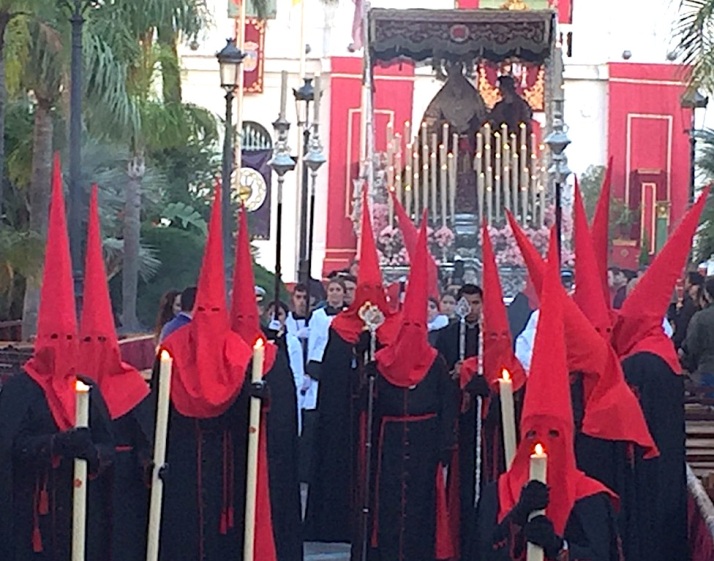
The Hooded Penitents of Semana Santa
The processions are solemn parades of hooded penitents, heavy elaborate floats, and marching brass bands that carry on late into the night. Each procession originates at its neighborhood church, and passes through the narrow streets and small plazas to the town’s main church or cathedral.

The March of the Passion Play
On Palm Sunday, the first procession of the week began with a hooded penitent carrying a giant cross. Close behind, additional repentant figures followed carrying candles and wearing long belted robes and tall conical hats that masked their identities. Some walked barefoot, carried wooden crosses, or dragged heavy metal chains.
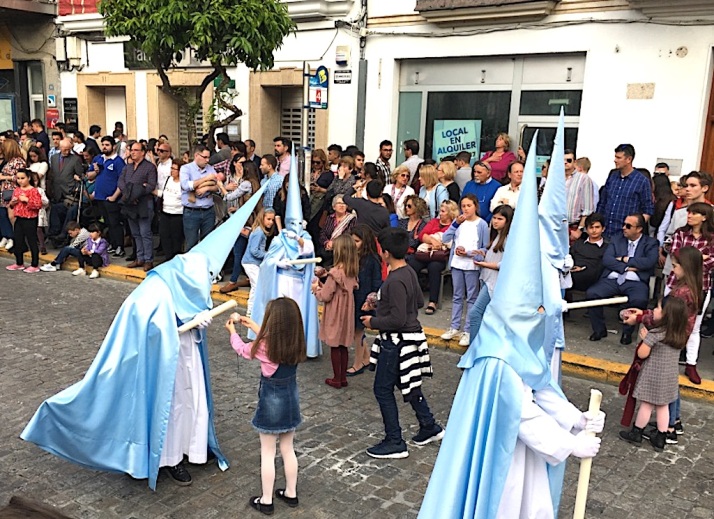
Children and their Balls of Wax
Amidst the gravity and seriousness of the procession, we observed families enjoying the traditions of the holiday. Street vendors sold hot potato chips and cone-shaped candy sticks, and children held balls of wax under the dripping candles.
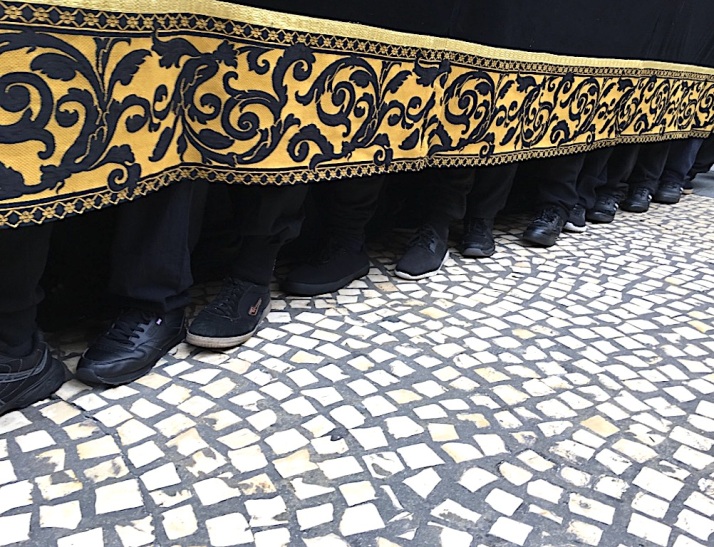
Feet of the Float Carrying Costaleros
Each procession included two elaborate floats, one of Christ and one of his mourning mother the Virgin Mary. As their own form of penance, dozens of burly men shouldered the heavy decorated platforms, and marched slowly and steadily for hours to the end of the parade route.
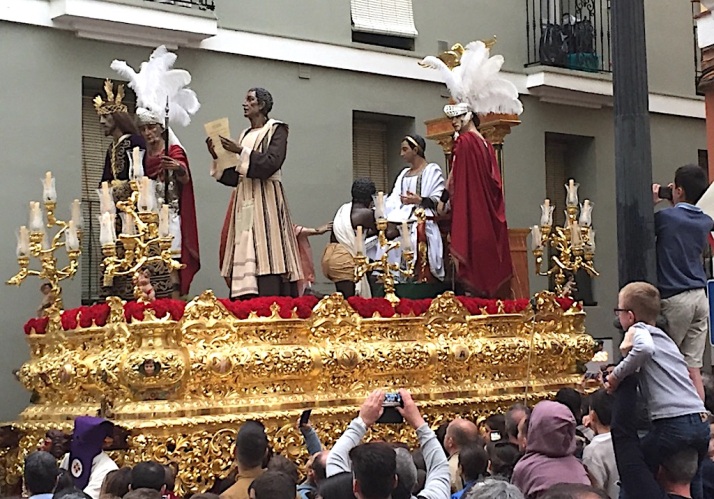
Gold-Plated Float in Cádiz
With great fanfare, the first float passed by, depicting the Palm Sunday triumphal entry of Jesus riding a donkey into the town of Jerusalem. The beautifully carved floats adorned with religious sculptures and gold-leaf are hundreds of years old and depict different episodes of the passion play.

Procession of the Virgin Float in El Puerto de Santa María
The polished silver-plated float bearing the Virgin Mary is carried at the tail of the procession. Festooned with flowers and rows of long white candles, the passing of the Virgin is greeted with excited applause, tears of the faithful, and showers of dried flower petals.

Marching Brass Band
Following each float, uniformed marching bands of horns, woodwinds, and drums played fervent religious compositions that echoed hauntingly between the walls of the narrow city streets. From balconies above the parade route, women moved by the spectacle cried out in the wailing song of the gypsy flamenco tradition.

Good Friday Sunrise Procession
The most significant period of Semana Santa is Holy Thursday night leading into the early morning of Good Friday. We woke early on Friday morning to attend the somber sunrise procession commemorating Christ’s crucifixion. In the chill of the pre-dawn hours, we watched penitents march by candlelight in quiet contemplation of the meaning of the coming day.

End of Easter Sunday Procession with Stork Flying Overhead
On Easter Sunday, as Christians worldwide celebrated the resurrection of Christ, we joined the cheerful crowds for the week’s final procession. With the church square filled to capacity, we followed as the final float passed beneath the carved baroque façade and disappeared through the large wooden basilica doors, thus concluding the holy week of Semana Santa in southern Spain.
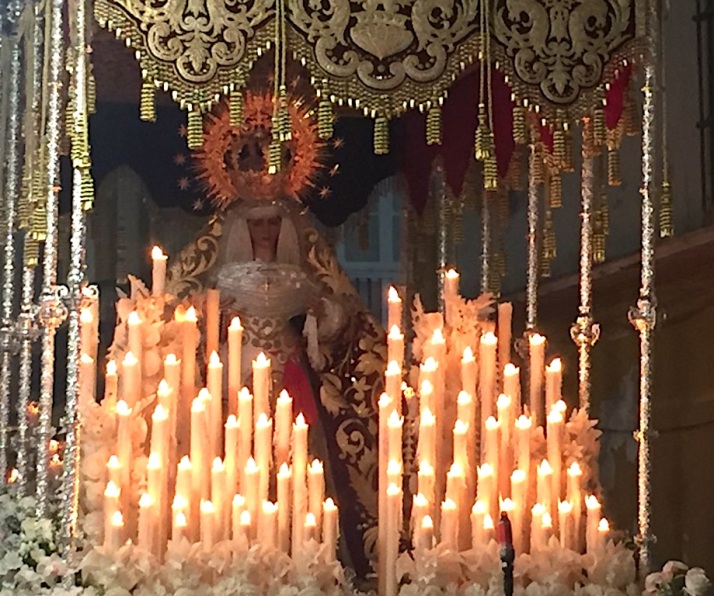
The Virgin by Candlelight

The procession looks amazing! We got to see one in Antigua Guatemala and it was an amazing experience!
LikeLiked by 1 person
It was a moving and awe-inspiring experience, Deb. As you know from your encounter in Antigua, the participants really put their whole heart into their devotion. Although I do not have the same degree of conviction, I am impressed with their demonstration of faith and admire their spirituality.
LikeLike
Amazing spectacle and you have captured it beautifully here. It is a great time to be in Spain, they really know how to do “Semana Santa”. There were some good celebrations here in Portugal, but we have not seen anything like what you and Esther have experienced in Spain. Looks like you had a great time
LikeLiked by 1 person
Spring is a great time to be in Spain, Gilda. The Spanish really know how to put on a dramatic and soul-stirring festival. The processions were hauntingly beautiful and the emotional musical compositions were especially poignant. I am happy to hear that you witnessed the holiday in Portugal. It is interesting to compare how Holy Week is celebrated throughout the Christian world.
LikeLiked by 1 person
How wonderful it must have been to get to see the celebrations first hand! I didn’t realize whole communities came together to re-enact Passion week. Thanks for sharing, with all the great photos too. Hope you had a great Easter!
LikeLiked by 1 person
I hope you had a great Easter too, Ann. For the first time in my 59 years, my birthday fell on Easter Sunday. Needless to say, it was a very special day for me. For Semana Santa, each church puts on numerous processions with different costumes and floats. The work involved to prepare for the week must be enormous.
LikeLiked by 1 person
Happy belated birthday!
LikeLiked by 1 person
Fascinating about the procession and the hooded Penitents, especially those wearing the white ones. Obviously the first thing I thought was how eerily similar they are to KKK robes from this country, but obviously it’s apparent where they stole it from. One is hate, but the other is based in peace and faith. That basilica looks OLD — very old. – Marty
LikeLiked by 1 person
It is initially shocking to see the robed and hooded penitents, especially for those of us from the United States. Of course the Semana Santa costumes have been around since the Inquisition, and are worn as a symbol of faith and repentance, instead of bigotry and hate. It was especially reassuring to see the young people in costume offering candle wax to the children along the parade route. The basilica in El Puerto is from the late 15th century, but its lack of exterior upkeep gives it an even older appearance. The stork nests on the belfry and buttresses have also been there for centuries.
LikeLiked by 1 person
It’s always amazing how elaborate religious rituals and temples are. Is it any wonder folks end up so tied to one flavor?
LikeLiked by 1 person
Indeed, Dave. The Semana Santa celebration is particularly traditional in Spain. By using detailed floats depicting the events of the Passion of Christ, the church educated and indoctrinated its illiterate followers. We have learned that many Spaniards are now non-practicing Catholics, but those that continue in their faith can really put on a show.
LikeLiked by 1 person
What an amazing experience that must have been! I bet even a heathen like me would have been moved by such a spectacle. I, like Marty, was initially surprised by the hooded costumes… but soon realized that they must have pre-dated the idiots in the KKK by quite a few years. Happy belated b-day to you!
LikeLiked by 1 person
Thank you, Janis. Although I am not a religious person, I was affected by the contrast between the solemnity of the hooded penitents, rousing music of the marching bands, and the zeal surrounding the parade floats. I was prepared to see the hooded costumes, but was surprised by the number of children parading under the hoods and robes. Witnessing it all was a very memorable experience.
LikeLike
Wow, that must have been quite an experience! Makes our own Easter celebration pale in comparison.
And you knew about the hoods ahead of time? Smart man.
LikeLiked by 1 person
I was prepared for a lot of hoods and candles, Christi. It was still kind of spooky to see. The celebration of Easter Sunday in Spain is a bit anticlimactic. They really focus their observance on the Passion of Christ during the week leading up to the resurrection. On Easter Sunday, we observed a Catholic mass and it didn’t seem any more festive than the ones I attended growing up in California.
LikeLiked by 1 person